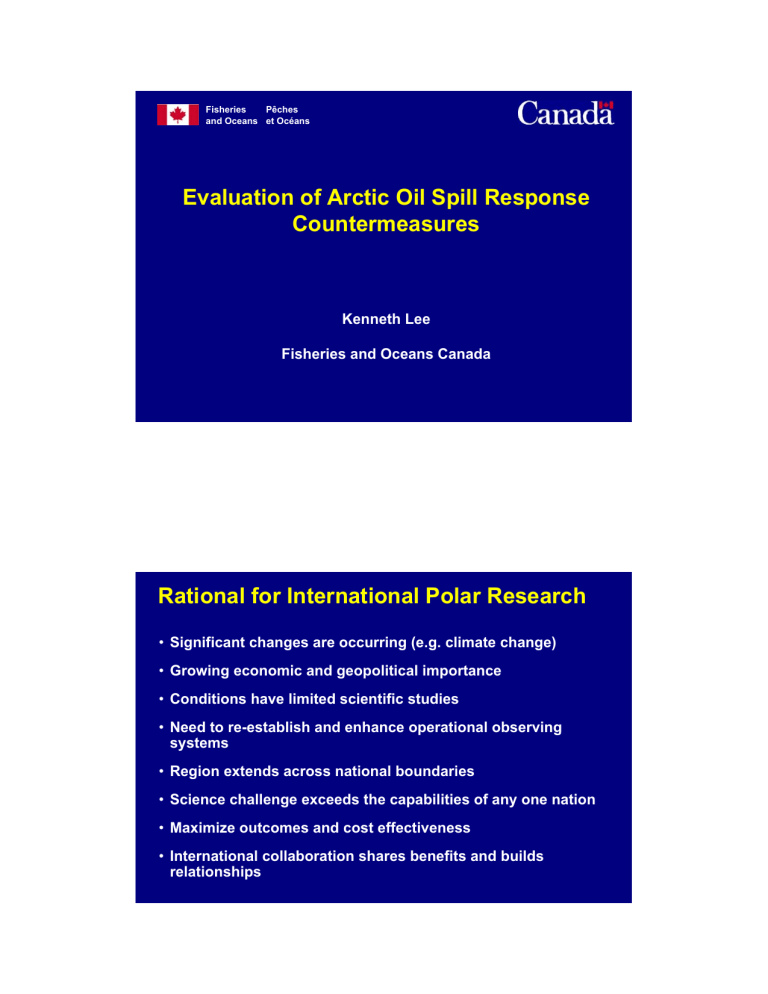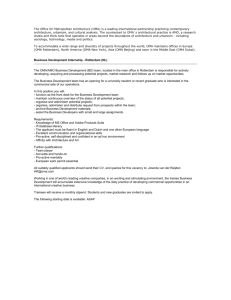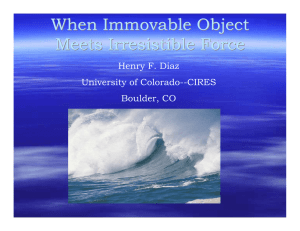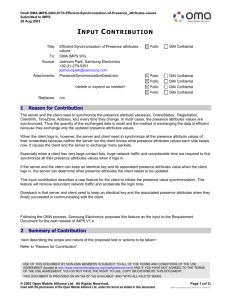Evaluation of Arctic Oil Spill Response Countermeasures Rational for International Polar Research

Fisheries and Oceans
Pêches et Océans
Evaluation of Arctic Oil Spill Response
Countermeasures
Kenneth Lee
Fisheries and Oceans Canada
Rational for International Polar Research
• Significant changes are occurring (e.g. climate change)
• Growing economic and geopolitical importance
• Conditions have limited scientific studies
• Need to re-establish and enhance operational observing systems
• Region extends across national boundaries
• Science challenge exceeds the capabilities of any one nation
• Maximize outcomes and cost effectiveness
• International collaboration shares benefits and builds relationships
International Polar Year (IPY) Program
• A major, international scientific event featuring a global campaign of coordinated polar observations and analysis
• March 2007 - March 2009 to allow for year round observations over two summer field seasons
• Build on experience gathered during the International Polar
Years of 1887 and 1907 and the International Geophysical Year of 1957 which focused on the polar regions
• Expected to be the largest-ever polar research program, valued at several billion dollars, and involving at least 30, but possibly as many as 50 countries and 20,000 or more people from around the world.
Co-sponsored by the International Council of Science (ICSU) and the
World Meteorological Organization (WMO) with endorsements by:
•
•
•
•
•
•
•
•
•
•
•
•
•
•
Antarctic Treaty Consultative Meeting (ATCM)
Arctic Council (AC)
AC - Arctic Monitoring and Assessment Programme (AMAP)
AC - Conservation of Arctic Flora and Fauna (CAFF)
Arctic Climate Impacts Assessment (ACIA)
Arctic Ocean Science Board (AOSB)
Arctic and Sub-Arctic Ocean Flux Programme (ASOF)
Committee of Managers of National Antarctic Programmes (COMNAP)
European Polar Board (EPB)
European Space Agency (ESA)
Forum of Arctic Operators (FARO)
International Arctic Science Committee (IASC)
International Arctic Social Scientists Association (IASSA)
International Hydrographic Organisation (IHO)
• International Oceanographic Commission (IOC)
• International Ocean Institute (IOI)
• International Permafrost Association (IPA)
• International Society of Photogrammetry and Remote Sensing (ISPRS)
• International Union of Geodesy and Geophysics (IUGG)
• International Union of Geological Sciences (IUGS)
• International Union of Radio Science (URSI)
• Scientific Committee on Antarctic Research (SCAR)
• Scientific Committee on Oceanographic Research (SCOR)
• University of the Arctic (UArctic)
• United Nations Environment Programme (UNEP)
• US Polar Research Board (US-PRB)
• US National Aeronautics and Space Administration (NASA)
Canada's Contribution to IPY
• $150 million in new funding over six years for innovative, interdisciplinary programs with international partners
• Priority: Science for climate change impacts and adaptation
Health and well-being of northern communities
• Funds available to government, university and community researchers through a competitive peer review process
• Provision of logistical support for research in Canada's North during the peak IPY period of 2007 to 2009
• Training, communication and outreach with Northern communities to increasing future the capacity to carry out science in Canada's North
• Consistent with the Northern Strategy Framework, including the promotion of northern science and research, reinforcing circumpolar cooperation, strengthening partnerships, and environmental protection
DFO Experimental Spill Experience
DFO has a history of collaborative international oil spill field trials (US, France, United Kingdom and Norway)
Fate of Marine Oil Spills: Physical, Chemical & Biological Processes
Atmospheric oxidation
(photo- oxidation)
Wind
Evaporation
Rain and/or
Fallout
Aerosol
Formation
Bulk surface discharge
Spreading Sea surface oil slick Spreading
Current movement
Water-in-oil emulsions
“chocolate mousse”
Tar balls
Dissolution
Sea surface Globular dispersion
Oil-in-water emulsion
Current movement and diffusion
Chemical degradation
Carbon cycle
Attachment to particulate matter
Dispersed crude oil
Biodegradation
Degradation or assimilation by fish
Bulk subsurface discharge
Biological detritus
Non-buoyant oil residues
Sea floor
Degradation or assimilation by bottom dwelling organisms
Sea floor sediments
Acceleration of Natural Recovery
Enhanced Dispersion:
Promotion of Oil Mineral Aggregate (OMA) Formation
Application of Chemical Oil Dispersants
Based on the premise of oil dispersion into the water column to concentrations below toxicity threshold limits and enhanced biodegradation of residual oil
Operational advantage – no need for physical removal and treatment of contaminated waste
Oil Mineral Aggregate (OMA) Formation
• Laboratory studies with oiled sediments from the Exxon
Valdez spill revealed that “micron-sized mineral fines, seawater and weathered oil” interact to form “clay-oil flocs”
(Bragg and Yang, 1993).
• The mechanism was responsible for the natural cleaning of sheltered shorelines in Prince Williams sound observed a year after the spill.
• Baffin Island Oil Spill (BIOS) Project - Natural cleansing was as effective as other tested countermeasures
• Clay-oil flocculation (Oil mineral aggregate formation – OMA) may be the cause of “natural self-cleaning” of shorelines affected by past oil spills.
Oil Mineral Aggregate (OMA) Formation
Interaction of micron-sized mineral fines (< 5 µm) with droplets of bulk oil to form solids-stabilized oil-in-water emulsion.
25 µm _____
Oil droplets
Mineral fines
Enhanced Biodegradation of n-alkanes with
Mineral Fines
oil oil + fines
100
80
60
40
20
0
100
80
60
40
20
0
DAY 7
DAY 56
Laboratory Study Conclusions
• OMA form with almost any kind of fine (<60 µm) mineral particles
• Incorporation of oil in OMA promotes its biodegradation and decreases oil toxicity and persistence in the environment.
• Significant amount of oil may be associated with OMA.
Enhanced OMA Formation as an Oil Spill
Response Countermeasure
Rational:
• The formation of Oil Mineral Aggregates (OMA) by the interaction between mineral fines and oil in seawater will facilitate natural dispersion.
• Oil droplets, once stablized by mineral fine interactions, stay separated and biodegrade at an accelerated rate.
Oil Loss - Site 3
2000
1500
1000
20
15
10
5 r ²=0.92
0
0 500 1000 1500
Kg of Oil Lost from Plot G / Day
500
No Treatment
Sediment Relocation
0
-10 0 10 20 30 40 50 60
Days
400
Results from Svalbard Experiment
• The quantity of OMA formed was proportional to the quantity of oil removed from the beach
• About 3% of the oil removed from the beach is likely to have settled within 1 km of the oiled sites
• The oil lost from the sites has been biodegraded and/or dispersed over a large area
• Toxicity in nearshore sediment and water samples was below allowable limits for ocean dumping of dredged spoils
Enhancement of OMA in the Presence of Ice in collaboration with the Canadian Coast Guard
Aim: Reduce costs of clean-up a spill in ice
• Investigate OMA formation at low temperature
• Evaluate mixing energy required
• Model significance
• Devise ways of dispensing minerals on or under the ice
• Biological effects
• Persistence of residual oil
Chemical Oil Dispersants
• Evaluation of factors controlling chemical oil dispersant efficacy
• Assessment of the net environmental effects
• Provision of data for dispersant use guidelines/policy
• Studies on oil dispersant / OMA interactions
• Arctic field trials
Enhancement of OMA in the Presence of Ice in collaboration with the Canadian Coast Guard
Aim: Reduce costs of clean-up a spill in ice
• Investigate OMA formation at low temperature
• Evaluate mixing energy required
• Model significance
• Devise ways of dispensing minerals on or under the ice
• Biological effects
• Persistence of residual oil




